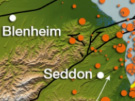The following questions and answers come from the Geohazards Ask-an-Expert web board. This web board closed one month after the field trip and a selection of posts were then moved to this page.
Which geohazards tend to be the most fatal to people and the environment, in New Zealand and globally?
Hi Jess, that's difficult to answer as earthquakes, volcanoes, landslides and tsunami have all caused large death tolls during big events in the past. If people live near a volcano it is difficult to get away quick enough if there is an eruption. Earthquakes can't be predicted so can be very dangerous if they are centered near a large population of people - like in the recent Nepal earthquakes. Landslides are also unpredictable while there may be some warning before a tsunami but they can still affect large areas and therefore be deadly like in Japan. So it all depends on where the geohazard is - if it is close to a densely populated area it is likely to be more deadly.
From Shelley the LEARNZ field trip teacher.
I was wondering why is it more common for bigger magnitude earthquakes to happen on the Ring of Fire?
Hi Brianna, earthquakes occur more at plate boundaries because that's where there is the most movement. Plates can slide past each other, collide or one plate can be pushed up or under another plate causing lots of friction - this energy is then released in earthquakes. More movement leads to more earthquakes and larger earthquakes especially along long fault lines. Where there is subduction volcanoes can occur too.
From Shelley the LEARNZ field trip teacher.
Do you know what weight the plates underground are and what kind of materiel are they?
Hi Alex, a tectonic plate is a massive, slab of rock, generally made up of both Continental and Oceanic crust - depending on where it is. Plate size can vary greatly, from a few hundred to thousands of kilometres across; the Pacific and Antarctic Plates are among the largest. I would not know how much a plate weighs - considering it is solid rock it would weigh a lot! - Continental crust is thicker than Oceanic crust.
From Shelley the LEARNZ field trip teacher.
How do we know if tectonic plates are real?
Hi there, good question. We know they exist because we can measure their movement and see land features from this movement. We would not have earthquakes or volcanoes without plate movement.
From Shelley the LEARNZ field trip teacher.
What was the largest earthquake ever recorded?
Hi Summer, the Great Chilean earthquake of Sunday, 22 May 1960 was the most powerful earthquake ever recorded, rating 9.5 on the moment magnitude scale.
From Shelley the LEARNZ field trip teacher.
What causes an eruption?
Hi there an eruption occurs where there is a subduction zone that allows magma to rise up to the surface through a weakness in the crust or through an already established volcanic vent. This vent may be blocked by old magma that cools after an eruption and solidifies into rock which eventually explodes with the pressure and heat of the rising magma. Or new volcanoes can form after plate movement causes magma to start rising up through a new crack in the crust.
From Shelley the LEARNZ field trip teacher.
What will happen if the tectonic plates block up?
Hi there, the plates are always moving very slowly. Stress builds up as land moves either side of a fault very slowly until the fault breaks or ruptures in an earthquake. Faults (lines of weakness in rock) lock up until they break in an earthquake rather than whole plates locking up.
From Shelley the LEARNZ field trip teacher.
Was the earthquake we had in New Zealand on Friday part of the same fault line as the earthquake that struck in Nepal?
Hi there, good question but no these earthquakes are not related and are on different tectonic plates.
From Shelley the LEARNZ field trip teacher.




